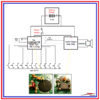Sir Bricago. . . . . . . . . . . . .( I'se done never mets myselfs a Bricago, before )('less'n that's Bri
an from Chicago )
[ Key up the eeeeeeeeeeerie organ music, and let the SEANCE continue ]
While I now "read the board" . . . . .
Keep up with my thought flow in the . . .
PHOTO REFERENCES . . . . . below
Your COMPLEX mean music machine function is being accomplished all within the "Le Chip ! " that is black epoxy ? mounted and covered up on the front side of that phenolic blank.
Its pin # 8 output is the music audio that connects at the BLUE oval , to the BLUE wire that is at the top end of the volume control.
In accordance to how loud you want to play, the movable pot wiper at the GREEN wire, feeds back to the board at my GREEN circle and routes down to an audio input pin of the audio amp chip. That nearest blue E-cap . . .possibly ? . . . . looks like it might be an in line coupler.
NOW . . . . .your task . . .Captain Kirk . . . . .should accept it . . . . . .is to surreptitiously get the identity of that RED X chip back to us ,as well as to use your ultra sub mini Minox spy camera and use the diagrams to ascertain which is being its pin #1. ( I put both possibilities down. )
Where I have the "Dig Here" RED X should be the 8 pin power audio amp for the speaker audio feed.
Worry . . .worry . . .WORRY . . . .all of it, being about that cheeeeep phenolic trim pot.
My . . . . VERY HIGHLY Edd-u-cated guestimation is that is being used in the final operational testing of the unit. You DON'T want to be sending out a mistuned SAX-a-ma-phone . . .DO YOU !
Look at the schematic redraw of that extreme corner circuitry. Its components are being color coded / for association.
Hypothetically . . .I'm randomly assigning 100k for that total resistive trios values.
Should I use the extreme 47 K values the 5 K should fall in the CENTER of that 100K value and then one should be able to s..l..o..w..l..y
VERNIER adjust within its limited adjustment range.
AND that will be a very VERNIER adjustment . . . . . not a ZIP - - - - - - -ZIP . . . .BAMMMM, like the touchy adjustment wiper of using a sole 100K pot would be.
Then, I also gave two other resistor sets values to let you see that that "sweet spot" adjustment / resistive point can be skewed around, up and down the 100K spread resistive spectrum / sector, just by those R1 and R3 resistor values, inter ratios being chosen..
Sooooooooooo what is happening here, is that there is being a master oscillator within the chip and that frequency gets divided down in digital stages to get all of the musical scale frequencies. With all of them being spot on, by virtue of the digital division resolving capability.
And then . . . . .AND THEN . . . . .
AND THEN ***** . . . . . the production line test person uses that trim pot to set that master oscillator frequency SPOT ON and then applies a dab of a fractable sealant to its rotor, to dry.
THE SPEAKER . . . . .
Looks like it uses two YELLOW wires going to the PCB and logically, end up at the RED X IC.
Can you now confirm if there is either of them making direct wired connection into an IC pin, or is a series E-cap in circuit ? . . . .but I don't see any on that immediate side of the board.
Gimme some feedback . . . . . . or more ?'s
ADDENDA . . . . .
Ach himmel ! I am 'chust now seeink , dat I dun bin havink lefted out dis final para-ma-graf
At dead center photo, seems to be the momentary contact TACT switch, I'm expecting to be its on off switch.
With consideration of it working with the boards two discrete transistors to make a power latching circuit, to initially power up the unit until the higher value resistor seen and its charge / timing capacitor companion, bleeds down and shuts the system power down.
BOARD REFERENCING . . . . .
73's de Edd . . . . .
F.I.O.
What does 73's mean in ham radio?
What does de mean in ham radio?
https://www.google.com/search?q=73's+de++.+.+.+.explanation&sxsrf=AOaemvLUVukJvuRZ-bKszZEYB9O1Mhg56Q:1637875152816&source=hp&ei=0P2fYaXxLu-iqtsP4oO6oAQ&iflsig=ALs-wAMAAAAAYaAL4G-90odFBgv6LjIH6uunuNTGSLwZ&ved=0ahUKEwilmau1uLT0AhVvkWoFHeKBDkQQ4dUDCA4&oq=73's+de++.+.+.+.explanation&gs_lcp=Cgdnd3Mtd2l6EAw6BwgjEOoCECc6BAgjECc6DgguELEDEIMBEMcBEKMCOgsILhCABBCxAxCDAToICAAQgAQQsQM6BQguEIAEOgUIABCABDoICC4QsQMQgwE6AggmOgQIABAeOgYIABAWEB46BQgAEIYDOgUIABDNAlDvDVj9sQFg4MoBaAFwAHgAgAGjAYgBphKSAQQyNC4zmAEAoAEBsAEK&sclient=gws-wiz
Edd
AND now . . . . . . .
TODAY’S STOCK MARKET REPORT
Helium is up.
Feathers are down.
Paper is stationary.
Fluorescent tubing was dimmed by light trading.
Knives were up . . . . sharply.
Cows steered into a bull market.
Pencils lost a few points.
Hiking equipment was trailing.
Elevators rose, while escalators continued their slow decline.
Weights were up in heavy trading.
Light switches were off.
Mining equipment hit rock bottom.
Diapers remained unchanged.
Shipping lines stayed at an even keel.
The market for raisins dried up.
Coca Cola fizzled.
Caterpillar stock inched up a bit.
SUN peaked at midday.
Balloon prices were inflated.
Scott Tissue touched a new bottom.
Huggy Diapers . . .also touched bottoms
And batteries exploded, in an attempt to recharge the market.
.


























